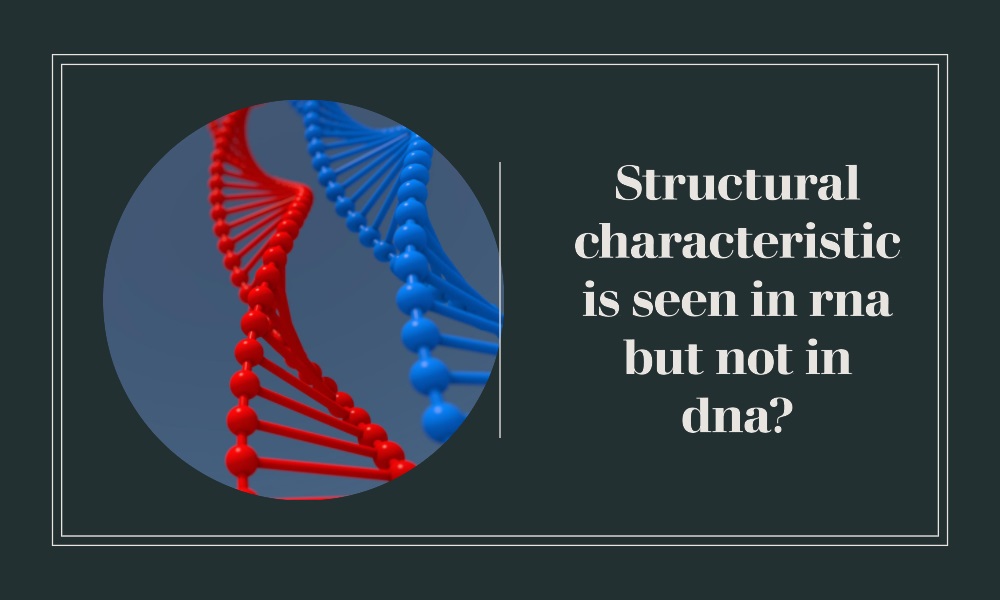In the vast and intricate world of molecular biology, RNA and DNA stand as two of the most fundamental molecules. Serving as the code and machinery of life, they contain our genetic information and dictate how organisms develop, function, and reproduce. But how do these two molecules differ? Specifically, which structural characteristics are unique to RNA and absent in DNA? Let’s dive in.
RNA and DNA: The Basics
At first glance, RNA (Ribonucleic Acid) and DNA (Deoxyribonucleic Acid) seem remarkably similar, both being nucleic acids. They share a similar structure of a sugar-phosphate backbone with nitrogenous bases extending from it. However, beneath these parallels lie critical differences.
The Fundamental Difference: The Sugar
The primary structural distinction between RNA and DNA lies in the sugar present in their respective backbones:
- DNA: Contains a sugar known as deoxyribose.
- RNA: Contains a sugar called ribose.
The difference? Ribose has one more hydroxyl group (OH) than deoxyribose. Specifically, deoxyribose lacks an oxygen atom that is present in ribose at the 2′ position. This seemingly minor distinction plays a significant role in determining the functions and properties of these molecules.
The Impact of this Structural Variation
This additional hydroxyl group in RNA affects the molecule in multiple ways:
- Stability: The absence of the 2′ hydroxyl group in DNA makes it more stable than RNA. The extra hydroxyl group in RNA increases the likelihood of hydrolysis, making RNA more susceptible to enzymatic degradation.
- Flexibility in Forming Structures: RNA, unlike DNA, can form a variety of secondary structures like hairpins and loops, thanks to the interaction of the 2′ hydroxyl group with other parts of the molecule.
- Functionality: The structural difference is partially responsible for the distinct roles of RNA and DNA. DNA’s stability is suited for long-term genetic storage, while RNA’s adaptability allows it to perform varied functions like protein synthesis and enzymatic activity.
Other Structural Differences Worth Noting
While the sugar difference is primary, it’s also worth noting other distinctions:
- Bases: RNA contains the base uracil (U) in place of the thymine (T) found in DNA.
- Strands: DNA is typically double-stranded, forming the iconic double helix. RNA, on the other hand, is usually single-stranded.
- Location: DNA is predominantly found in the cell nucleus, whereas RNA can be found throughout the cell.
FAQs
Why does RNA have ribose instead of deoxyribose?
The presence of ribose allows RNA to perform a diverse range of functions. Its relative instability compared to DNA ensures that it doesn’t permanently store genetic information, allowing it to be more transient and adaptable.
Can RNA store genetic information like DNA?
While DNA is the primary genetic material in most organisms, certain viruses use RNA as their genetic material.
What’s the significance of RNA having uracil instead of thymine?
This is mainly a result of the enzymatic machinery and the metabolic pathways involved in nucleotide synthesis. Uracil is energetically cheaper to produce, and since RNA is more transient than DNA, there’s less need for the added stability that thymine provides.
Do the structural differences impact the replication of RNA and DNA?
Yes, the enzymes and mechanisms that replicate RNA and DNA are different due to these structural variations.
Conclusion
RNA and DNA, while sharing many similarities, have distinct structural characteristics that define their roles in biology. The presence of ribose in RNA and its absence in DNA is a crucial distinction, influencing the stability, functionality, and overall nature of these nucleic acids. Recognizing this difference is fundamental in understanding the intricate dance of genetics and molecular biology.











